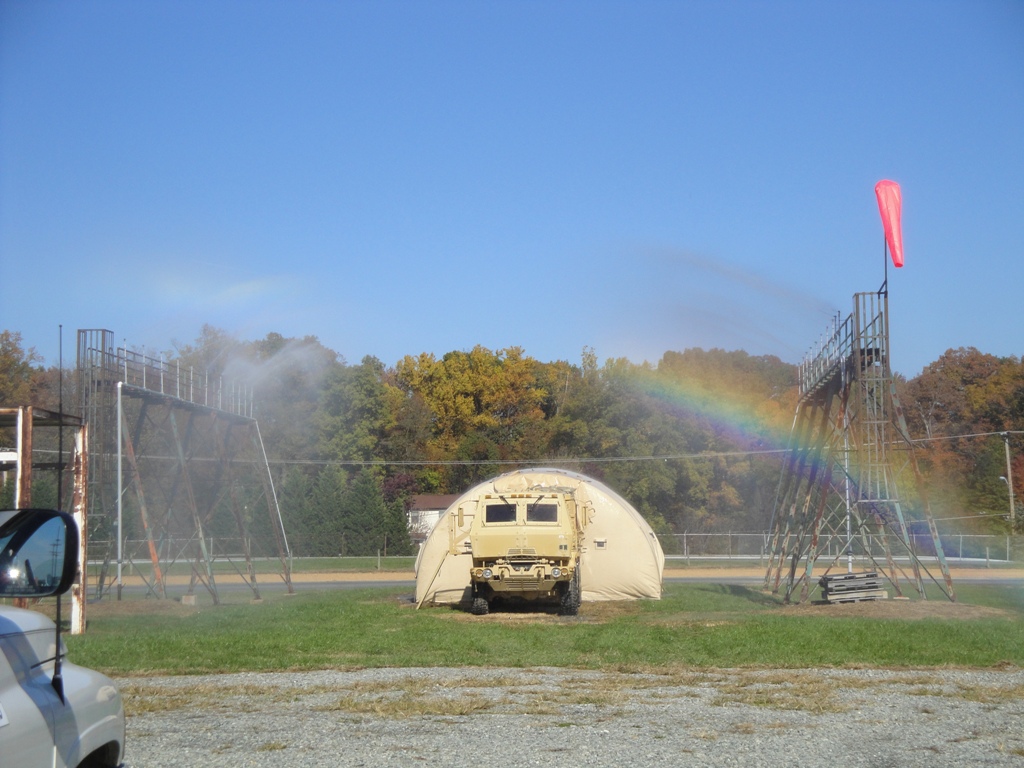Unconventional Weapons Protection
Daniel R. HubbertChief, Chief,
Force Sustainment and Chemical/Biological Protection Branch, Soldier Systems Division, Warfighter Directorate
The CBPS undergoes rain testing to determine the shelterís resistance to rain infiltration.
Since sixth century BC, chemical and biological weapons have existed, developing into greater threats over the ensuing millennia. Some of the earliest references to toxic warfare include burning projectiles, poisoning water, catapulting plague-infected bodies and creating blinding smoke screens. The development of modern chemistry in the mid-19th century helped increase the sophistication of toxic weaponry.
Although outlawed by the 1972 Biological Weapons Convention and 1993 Chemical Weapons Convention, recent headlines have brought the shadow of chemical and biological warfare back into public consciousness.
The ongoing threat of chemical-biological attacks necessitates a broad mission for the DODís Joint Program Executive Office for Chemical and Biological Defense (JPEO CBD). JPEO CBD exists to enable the U.S. Armed Forces to prepare, protect, prevent, respond and recover within the realm of chemical and biological, as well as radiological and nuclear, defense.
Although ATC is not the primary U.S. Army Test and Evaluation Command (ATEC) test center for chemical and biological defense systems, ATC plays a key role in the development and fielding of these systems. The systems undergo testing in environmental extremes such as low and high temperatures and blowing rain, sand and dust. ATCís test courses and vibration facility are used to assess the ability of the systems to withstand the shocks and vibrations of transport over some of the planetís roughest terrains, in varied environments.
At any moment, ATCís Force Sustainment and Chemical/Biological Protection (FS&CBP) Branch might be testing several chemical and biological defense systems. One system currently under test is the Next Generation Chemical Detector, designed to detect and identify chemical warfare agents in real-world scenarios. Subjecting the system candidates to high and low temperature extremes, as well as to extreme humidity, produces data necessary for the program manager to make an informed decision about system capabilities.
FS&CBP also answers the call for testing less common, but no less important, real-world needs. The Soldier-specific Dismounted Reconnaissance Sets, Kits, and Outfits system has undergone upgrades, including a change in radios that require speech intelligibility testing. On a reconnaissance mission for chemical, biological, radiological or nuclear weapons, communication is keyóbut the required personnel protective equipment includes a full face mask and gloves, making it difficult to handle a radio. Although rigorous and time-consuming, speech intelligibility testing ensures radios are compatible with all required protective equipment.
In addition to protecting personnel in theater, the DOD must be prepared to transport chemically or biologically contaminated human remains in a safe manner that protects all involved. FS&CBP supports this effort by performing tests on contaminated remains transport systems. Similar to the transport requirements for all hazardous chemicals and biological substances, these transport systems must pass rigorous hazardous material transportation requirements to comply with numerous international and federal regulations.
As technology advances, chemical and biological threats become more sophisticated and dangerous, and the ability to protect and detect becomes ever more challenging. At ATC, the men and women of the FS&CBP Branch are proud to provide testing in support of this mission.
You are now leaving www.atc.army.mil and entering another site. You will automatically be forwarded to the target page within five seconds.

